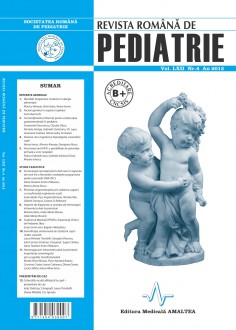SELECT ISSUE

Indexed

| |

|
|
|
| |
|
|
|

|
|
|
|
|
|
|
HIGHLIGHTS
National Awards “Science and Research”
NEW! RJP has announced the annually National Award for "Science and Research" for the best scientific articles published throughout the year in the official journal.
Read the Recommendations for the Conduct, Reporting, Editing, and Publication of Scholarly work in Medical Journals.
The published medical research literature is a global public good. Medical journal editors have a social responsibility to promote global health by publishing, whenever possible, research that furthers health worldwide.
EFFICIENCY OF OXYGEN THERAPY BY HEAD BOX FOR ACUTE RESPIRATORY FAILURE IN INFANTS
Ioana Badiu Tisa, Angela Butnariu, Nicolae Miu, Gabriel Samasca and Sorana D. Bolboaca
ABSTRACT
Oxygen therapy is the main treatment method for acute respiratory failure in children. The method consisting in the administration of oxygen therapy by head box to infants is frequently used in pediatric practice.
Objectives. To evaluate the efficiency of oxygen therapy administered by head box to infants suffering from pneumogenic acute respiratory failure by comparing two methods for measuring hemoglobin oxygen saturation: in arterialized capillary blood and by pulse oximetry.
Material and method. 30 infants suffering from pneumogenic acute respiratory failure were studied. We used a clinical appraisal score for acute respiratory failure, which appraises respiratory rate, nasal flaring, recession, cyanosis, sensorial, before and after oxygen therapy. In arterialized capillary blood we measured partial pressure of oxygen and hemoglobin oxygen saturation, and we used an Automatic Blood Gas System analyzer. We also measured hemoglobin oxygen saturation using a pulse oximeter. Determinations were made before the initiation of oxygen therapy, and 30 minutes and 60 minutes after the initiation of oxygen therapy.
Results. As compared to the baseline values, determined before the initiation of oxygen therapy, we recorded a statistically significant improvement in the clinical score both after 30 minutes and 60 minutes from the initiation of oxygen therapy (p<0.001). The improvement was greater after 60 minutes. The increase in the partial pressure of oxygen was statistically significant both at the 30 minute and 60 minute determination (p<0.001). Both methods of SaO2 measurement recorded statistically significant increases (p<0.001) in this variable after 30 and 60 minutes, respectively.
Conclusions. Oxygen therapy administered by head box improves acute respiratory failure appraised by clinical score. The administration of oxygen therapy by head box to infants significantly increases the values of partial pressure of oxygen and hemoglobin oxygen saturation measured in capillary blood, as well as the values of hemoglobin oxygen saturation determined by pulse oximeter both after 30 minutes and after 60 minutes. The increases in the three parameters are larger after 60 minutes. There is statistically significant concordance between the values of hemoglobin oxygen saturation determined in capillary blood and by pulse oximetry at all determinations.
Key words: partial pressure of oxygen, Astrup parameters, hemoglobin oxygen saturation, pulse oximetry
